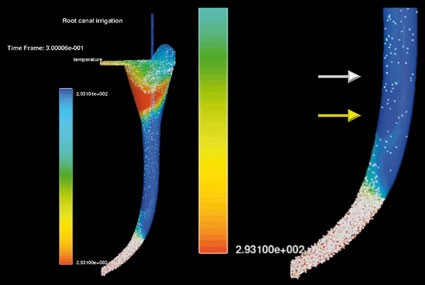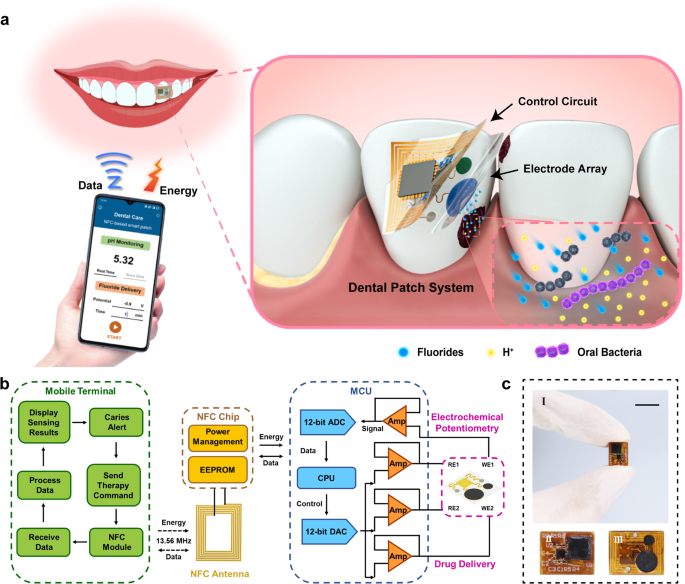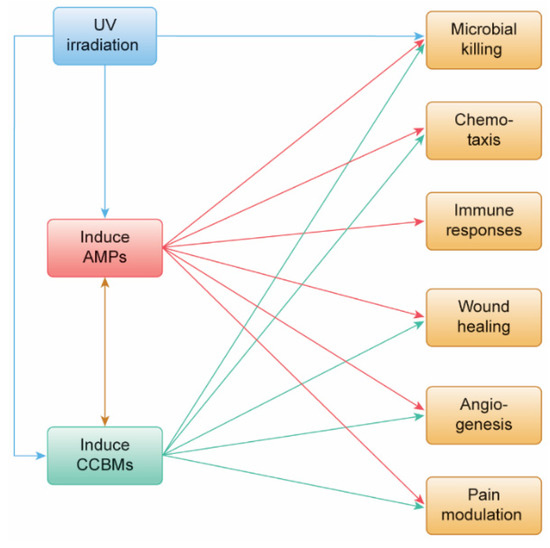Introduction to Antimicrobial Peptides in Endodontics
Antimicrobial peptides (AMPs) are transforming the field of endodontics by offering a novel approach to addressing persistent bacterial infections within root canals. These short sequences of amino acids are found naturally in various organisms and play a vital role in innate immunity. Their ability to target and neutralize resistant bacterial strains has generated significant interest in their application for endodontic treatments.

Image source: Source
Root canal infections are notoriously challenging due to the presence of biofilms and resistant bacteria, which often render traditional antibiotic treatments ineffective. This has highlighted the need for innovative strategies that can effectively target these resilient microbial communities. AMPs present a promising solution with their unique mechanisms, such as disrupting bacterial membranes and inhibiting biofilm formation. These properties, as discussed in the article “Antimicrobial peptides: Redefining endodontic therapeutics” (source), offer a multifaceted approach to infection control, potentially reducing the risk of resistance development.

Image source: Source
The potential of AMPs in endodontics is increasingly recognized, with their biocompatibility and ability to degrade biofilms making them an attractive alternative or adjunct to existing procedures. This aligns with a broader shift in the dental field towards more sustainable antimicrobial strategies, reducing reliance on traditional antibiotics. As the dental profession moves towards these new horizons, ongoing research and development are crucial. Studies like “Harnessing antimicrobial peptides in endodontics” (source) underscore the importance of optimizing the use of AMPs to fully realize their potential in revolutionizing dental care.
Evaluating Current Endodontic Practices
Traditional endodontic treatments typically involve mechanical debridement and chemical irrigation using agents like sodium hypochlorite and ethylenediaminetetraacetic acid (EDTA). These methods are designed to eliminate bacteria from root canals, but they face limitations, particularly with the increasing challenge of antibiotic resistance.

Image source: Source
A major issue in current practices is the difficulty in fully eradicating biofilms. Biofilms consist of complex bacterial communities that adhere to surfaces within the root canal system, often resistant to traditional treatments. This resistance can lead to persistent infections, necessitating retreatment or surgical intervention.
Antibiotic resistance further complicates endodontic treatments. The overuse of antibiotics has accelerated the prevalence of resistant strains, reducing the effectiveness of these drugs. This highlights the urgent need for innovative solutions that can enhance treatment efficacy without relying on antibiotics.
Antimicrobial peptides (AMPs) are emerging as potential game-changers in endodontic therapy. AMPs have unique properties that enable them to target and dismantle biofilms more effectively than conventional methods, offering a strategy to combat resistant strains without the side effects associated with traditional antibiotics. According to a recent study, AMPs represent a promising avenue for next-generation antimicrobial strategies.

Image source: Source
As the dental community seeks to improve patient outcomes and tackle antibiotic resistance, the integration of novel solutions like AMPs could signify a pivotal shift in endodontic practices. This evolution not only promises more effective treatments but also supports the development of sustainable and targeted antimicrobial strategies.
Innovative Uses of Antimicrobial Peptides in Endodontics
Antimicrobial peptides (AMPs) represent a groundbreaking innovation in endodontics, offering a significant shift from traditional antibiotic treatments. These naturally occurring molecules are integral to the innate immune response and are characterized by broad-spectrum activity. Unlike conventional antibiotics, which target specific bacterial functions, AMPs disrupt microbial membranes directly, leading to rapid bacterial death and reducing the risk of resistance development. This unique mechanism makes AMPs particularly effective against resistant bacterial strains commonly found in root canal infections.
Recent studies emphasize the superior efficacy and safety of AMPs compared to traditional antibiotics. They have shown promising results in vital pulp therapy and root canal treatment, effectively targeting and eradicating pathogenic bacteria. For example, the DJK-5 peptide, when used alongside ethylenediaminetetraacetic acid (EDTA), has demonstrated significant antimicrobial efficacy. This combination disrupts biofilms and significantly reduces bacterial load, offering a powerful alternative to standard treatment protocols. source
The development of synthetic AMP mimics, integrated with cutting-edge technologies like nanotechnology, opens new possibilities for enhancing treatment outcomes. These innovations not only improve the stability and delivery of AMPs but also expand their functional versatility, providing more effective targeting of bacterial biofilms, a persistent challenge in root canal therapy.

Image source: Source
The growing embrace of AMPs in endodontics marks a shift towards sustainable and biocompatible antimicrobial strategies. Supported by a robust body of evidence and innovative research, this transition promises a new era of dental care that prioritizes both efficacy and safety in treating complex infections. As research progresses, AMPs continue to challenge traditional approaches, paving the way for groundbreaking advances in dental treatment.
Transforming Root Canal Treatments with AMPs
In the realm of endodontics, antimicrobial peptides (AMPs) are paving the way for transformative advancements in root canal treatments. Traditionally, endodontic procedures have relied on irrigation solutions like sodium hypochlorite and EDTA to manage bacterial infections. However, the integration of AMPs, particularly in combination with existing agents, is proving to be a game-changer.
The DJK-5 peptide, when used alongside EDTA, exemplifies this innovation by demonstrating significant antimicrobial efficacy. DJK-5 effectively disrupts biofilms and substantially reduces bacterial load within the root canal system. This combination enhances the elimination of resistant bacterial strains, addressing the limitations posed by conventional irrigation solutions. According to a study on the antimicrobial efficacy of DJK-5 peptide in combination with EDTA, the synergy between AMPs and EDTA enhances overall antimicrobial activity, offering a promising alternative to traditional methods.

Image source: Source
Clinical trials have further underscored the potential of AMPs in endodontic treatments. In several trials, AMPs have been shown to reduce treatment times and improve patient outcomes by effectively targeting and eradicating persistent infections. These findings suggest that AMPs could significantly enhance the quality of root canal therapy, providing a more efficient and patient-friendly approach.
As research into AMPs continues to evolve, their application in routine dental practice grows ever more promising. By bridging the gap between current limitations and future possibilities, AMPs hold the potential to redefine the standards of root canal treatments. How might future developments further enhance their efficacy and integration into dental care?
Pioneering Advances in AMP Technology
The development of synthetic antimicrobial peptide (AMP) mimics, combined with cutting-edge nanotechnology, is at the forefront of transforming endodontic treatment. This innovative approach enhances the effectiveness of AMPs and broadens their potential applications in dental care. The integration of these synthetic mimics with nanotechnology is pivotal in combating bacterial biofilms, which are notoriously resilient to conventional treatments.

Image source: Source
One promising aspect of this advancement is the design of synthetic AMP mimics that replicate the natural mechanisms of AMPs while providing enhanced stability and activity. Researchers have engineered these mimics to resist proteolytic degradation, extending their functional lifespan in the harsh environment of the oral cavity. This enhanced stability ensures that AMPs maintain their antimicrobial efficacy throughout the treatment process.
Nanotechnology further amplifies the capabilities of these synthetic mimics. By using nanoparticles as delivery vehicles, it is possible to achieve targeted delivery of AMPs to infection sites. This approach not only increases the concentration of AMPs at the site of infection but also minimizes potential side effects, enhancing patient safety and treatment outcomes. Nanoparticles can be engineered to control the release of AMPs, allowing for a sustained antimicrobial effect, particularly beneficial in treating persistent infections.
The applications of these advances are vast. For example, the use of synthetic AMPs integrated with nanotechnology could lead to more effective treatments for bacterial biofilms on dental surfaces, a common challenge in endodontics. Such biofilms are often resistant to traditional antibiotics, but the enhanced penetration and prolonged action of AMP-loaded nanoparticles offer a formidable solution.
Looking ahead, the continued exploration and refinement of AMP technology promise to redefine dental care’s landscape. By harnessing the synergistic potential of synthetic mimics and nanotechnology, we are paving the way for more efficient, targeted, and sustainable antimicrobial treatments. This transformative approach holds promise not only for endodontics but also for broader medical applications where bacterial resistance poses a significant challenge.
Addressing Challenges and Considerations of Antimicrobial Peptides in Endodontics
As antimicrobial peptides (AMPs) continue to gain traction in redefining endodontic treatment, several unique challenges and considerations emerge. One pressing concern is the potential development of resistance to these peptides. While initially thought to be less susceptible to resistance compared to traditional antibiotics, recent findings suggest otherwise. Ongoing research is essential to uncover the mechanisms behind this resistance and develop strategies to counteract it. Recent studies highlight the need for continued investigation in this area.

Image source: Source
Regulatory hurdles pose another significant challenge. Introducing AMPs into clinical practice requires thorough evaluation by regulatory bodies to ensure both safety and efficacy. This rigorous process, although necessary, can be both time-consuming and costly, potentially delaying the adoption of AMPs in endodontic treatments. Additionally, navigating the diverse regulatory landscapes across different regions adds complexity to their implementation.
Safety concerns, particularly regarding the cytotoxicity of AMPs, are vital to address. While promising in laboratory settings, translating these findings to clinical applications demands comprehensive research into their long-term effects on human tissues. Achieving a balance between biocompatibility and antimicrobial efficacy is crucial for successful clinical integration.
Cost and accessibility also impact the potential widespread use of AMPs in endodontics. The production of AMPs can be expensive, potentially leading to higher costs for patients. This raises questions about the accessibility of these advanced treatments across different socioeconomic groups. Developing strategies to reduce manufacturing costs and ensure equitable access will be key to integrating AMPs into mainstream dental care.
Addressing these challenges requires a collaborative effort among researchers, clinicians, and policymakers. By fostering interdisciplinary collaboration and prioritizing research in these areas, the transformative potential of AMPs in endodontic treatment can be fully realized.
Speculative Insights into the Future of Dental Care
The integration of antimicrobial peptides (AMPs) into dental care, particularly in endodontics, holds promise for transforming current practices. AMPs offer a sustainable solution to combat resistant bacterial strains, reducing the reliance on traditional antibiotics. This shift may enhance the efficacy of treatments for persistent infections and broaden applications within oral health.

Image source: Source
AMPs’ unique ability to target and disrupt biofilms positions them as valuable tools in preventive dental care. For example, AMP-infused dental products could actively combat plaque and bacteria, potentially reducing the incidence of cavities and periodontal disease. Such products might extend the interval between dental visits and improve overall oral health by augmenting routine dental cleanings.
Looking ahead, personalized dental care regimens incorporating AMPs could be tailored to an individual’s microbiome. This approach would not only address current infections but also help prevent future issues, aligning with broader trends in personalized medicine. Continued research into AMPs may further reveal their utility in other areas of medicine, such as in systemic infection treatment or wound care protocols.
Ongoing research and collaboration among scientists, clinicians, and industry stakeholders are crucial to realize the full potential of AMPs in dental care. This proactive, personalized approach promises to enhance patient outcomes and public health. For further insights, see Therapeutic Uses for Antimicrobial Peptides in Oral Healthcare.
Future Directions and Potential Impacts in Endodontics
The field of endodontics is on the cusp of significant change, primarily due to the promising role of antimicrobial peptides (AMPs). These peptides are poised to redefine treatment paradigms with their targeted action against resistant bacterial strains and ability to disrupt biofilms. This presents a viable alternative to traditional antibiotics, which are increasingly challenged by resistance issues. AMPs offer a biocompatible approach that aligns with the shift towards more sustainable and effective endodontic practices.

Image source: Source
Despite their potential, the integration of AMPs into endodontic treatment protocols comes with challenges. The emergence of resistance to AMPs, though initially considered unlikely, has been observed, necessitating ongoing research and innovation. Moreover, regulatory and safety considerations must be addressed to facilitate their widespread adoption in dental practices. Overcoming these hurdles is crucial to fully realize the benefits of AMPs.
Looking ahead, the incorporation of AMPs could drastically reduce reliance on conventional antibiotics, providing a robust response to the global challenge of antibiotic resistance. The development of synthetic AMP mimics, enhanced by nanotechnology, holds promise for more precise and effective interventions. As research progresses, these innovations may not only improve endodontic outcomes but also inspire broader applications in dental care.
AMPs represent a groundbreaking advance in endodontic therapy, with the potential to offer targeted, effective, and sustainable solutions. Achieving this future requires a blend of scientific exploration, regulatory foresight, and clinical adaptability. As these elements come together, the potential of AMPs to revolutionize endodontic care becomes increasingly tangible. For further insights into the revolutionary impact of AMPs in endodontics, you can explore the detailed study by Kong et al. 2024 here.
